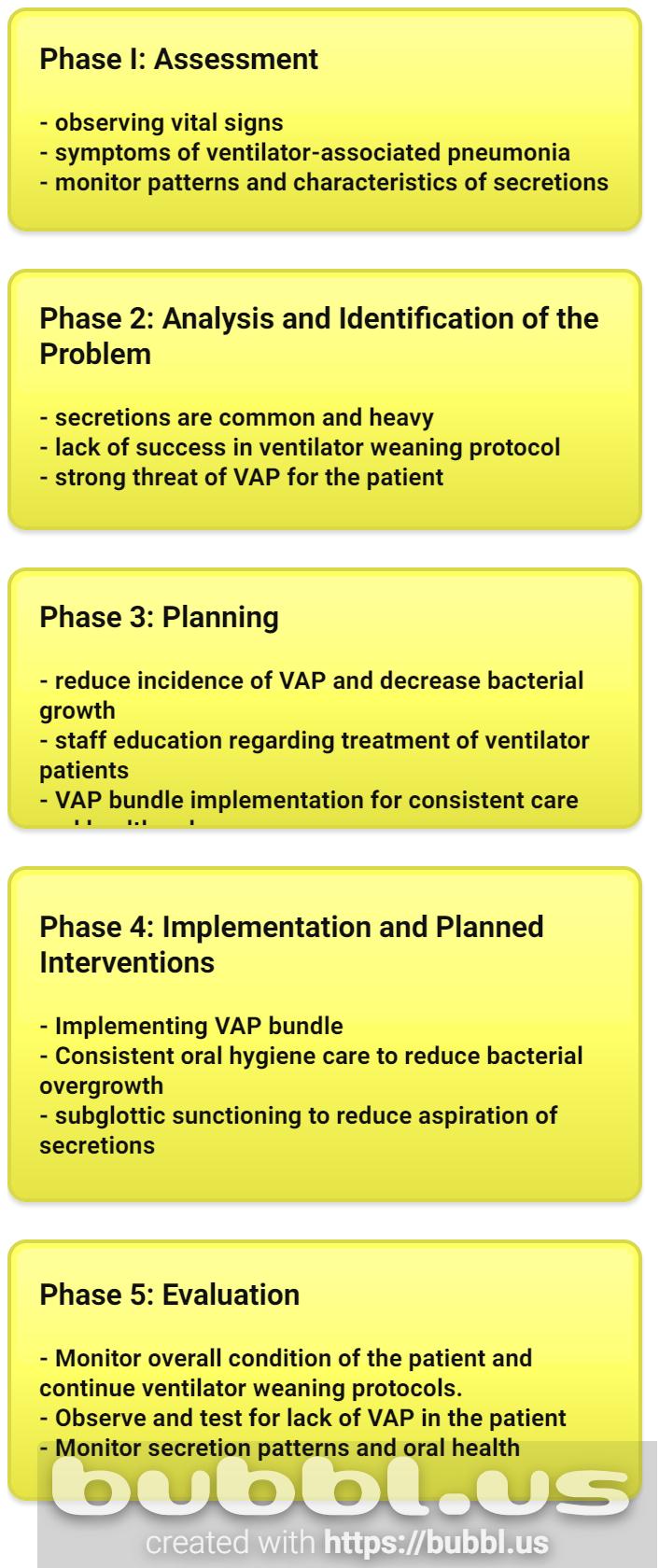Phase 1: Assessment
This phase is the initial start to the nursing process consisting of gathering information about the patient, their disease, and physiological, psychological, sociocultural, developmental, spiritual, and environmental information. Nurses can obtain subjective data such as observations and patient communication or objective data through examination and measurable vital signs (Black, 2016). This phase is most comparable to the collection of data/physical assessment stage of the clinical decision process. Critical thinking comes into play with the nurse asking key questions such as what the underlying issue of the condition is and what exact information is necessary along with the validity of data. In this case, assessment of the patient’s physical condition is necessary concerning signs of ventilator-associated pneumonia. It is also potentially beneficial to monitor patterns and characteristics of secretions, as well as the general condition of the patient.
Phase 2: Analysis and Identification of the Problem
Data collected during phase 1 must be validated and then clustered to be analyzed and compared to standards to identify the exact nature of the problem. This is characterized as a nursing diagnosis which is defined as a health problem which nurses are licensed to treat due to their education and experience. Nursing diagnoses differ from medical diagnoses decisions which occur at this stage in the clinical decision process, as a nursing diagnosis describes the human response and result of the disease process (Black, 2016). Critical thinking is vital at this stage as it requires evaluating the meaning of the collected data based on available facts and evidence and establishing a foundation to developing an efficient plan of care. For the case, the nursing diagnosis would be a strong threat of VAP due to continuous secretions around the endotracheal tube and difficulty of success in ventilator weaning protocols.
Phase 3: Planning
The phases consist of identifying patient goals which are used to guide the selection of interventions that can improve patient progress and condition. There must be short-term goals and long-term outcomes with specific and measurable outcomes. In the clinical decision process, this phase is relevant to considering an intervention to determine its treatment threshold. Critical thinking is applied at this stage by weighing immediate and long-term priorities, formulating interventions and clinical care plans, and individualizing the plan of care to the specific situation. It requires a cognitive balanced approach to considering numerous factors (Black, 2016). Patient goals are to reduce the incidence of VAP infection and to wean the patient off the ventilator, improving recovery. The best approach would be to use a comprehensive care bundle approach that has been proven to reduce VAP rates. It consists of a group of small but consistent practices in the care of a patient on a ventilator. First, there is education provided to staff regarding ventilated patients, which may aid in addressing the clash of the experienced nurse in the case study. The VAP bundle consists of elevation of the head, daily sedation breaks, daily assessments of HAIs and readiness to extubate, and care hygiene for oral health and subglottic suctioning for secretions which are most important (Alcan et al., 2016).
Phase 4: Implementation of Planned Interventions
At this phase, the nursing orders are carried out based on the analysis and thinking that have been taken in the phases leading up to this, to ensure the safe and appropriate nature of care. In clinical decision-making, this phase matches the therapeutic decision and implementation stage. Despite this being an action phase, it requires critical thinking as a nurse must act thoroughly, consistently evaluating the patient’s status and considering new facts and problems. Interventions may have to be modified based on responses, and data collection continues for further evaluation (Black, 2016). Oral hygiene care provision can reduce bacterial overgrowth and the risk of infection. Establishing coordinated care for subglottic suctioning due to aspiration of secretions. Subglottic suctioning can reduce the rate of VAP by as much as 45%, combined with oral hygiene care and other bundle care mechanisms, the risk of VAP goes down significantly (Boltey, 2017)
Phase 5: Evaluation
As the final phase of the nursing process, the nurse seeks to examine the patient’s progress regarding the initial goals and use outcome criteria in identifying problem resolution. This phase matches the observation of treatment outcome in clinical decision-making. Critical thinking is extremely important at this stage as it is a reflective stage at which the nurse considers all previous decisions and the effectiveness of the care plan, whether everything was done competently and successfully. It is a challenging cognitive consideration of various factors in the intellectual tools and decision-making or problem-solving utilized (Black, 2016). For this case, it is necessary to monitor the patient’s condition and continue other interventions for ventilator weaning protocols that would hopefully succeed if the condition improves. Testing and observing for VAP or potential HAIs is important. Secretion patterns continue and oral hygiene health monitoring remains a key indicator of VAP prevention.
Mind Map

References
Alcan, A. O., Demir Korkmaz, F., & Uyar, M. (2016). Prevention of ventilator-associated pneumonia: Use of the care bundle approach. American Journal of Infection Control, 44(10), e173–e176. Web.
Black, B. (2016). Professional nursing: Concepts & challenges (8th ed.). Saunders.
Boltey, E., Yakusheva, O., & Costa, D. K. (2017). 5 Nursing strategies to prevent ventilator-associated pneumonia. American nurse today, 12(6), 42–43. Web.